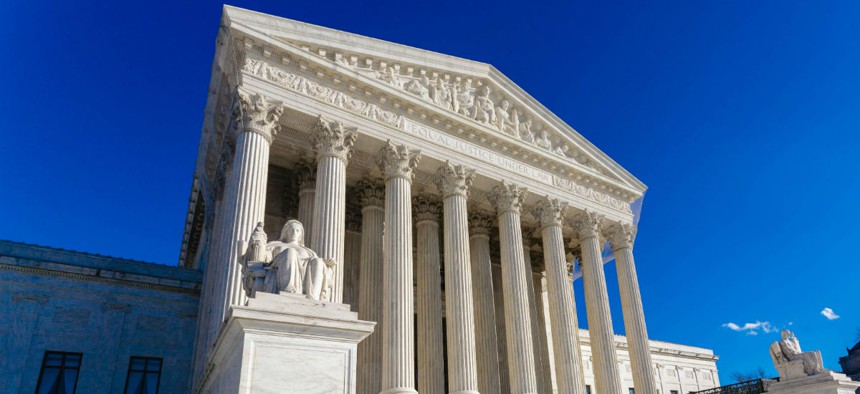How a Deadlocked Supreme Court Provided a Major Boost to Federal Employee Unions
A decision this week was a win for state and local government unions, but helps feds too.
Federal employees may have scored an unforeseen victory in a split Supreme Court decision announced Tuesday, which on its face only impacted public sector groups at the state and local level.
The deadlocked four-four vote in Friedrichs v. California Teachers Association will leave intact a decision by a lower court, effectively allowing state and local government employee unions to continue to collect “fair-share” or “agency” fees. The policy enables a labor group to automatically enroll employees joining their collective bargaining unit into their organizations and collect the corresponding dues from them.
While federal employee unions are also required to represent and bargain on behalf of everyone in their collective bargaining units -- whether or not the employees proactively elect to join the group and pay dues -- they are prohibited in statute from collecting fair-share fees. However, the labor groups are entitled to “official time,” in which federal employees receiving federal salaries and working in federal offices spend up to all of their time conducting union activities.
Republicans in Congress have for years targeted official time, calling it a waste of taxpayer dollars. The most recent report on the practice showed agency employees spent 3.43 million hours on official time in fiscal 2012, up 1.3 percent from the previous year and costing $157.2 million.
Federal union officials often point to their inability to charge fair-share fees to justify the use of official time; because they are representing employees that do not pay dues, the argument goes, lawmakers have since 1978 allowed unions to negotiate with agency management over the appropriate use of official time.
Official time also comes with fiscal benefits, unions have argued, as it allows for resolution of disputes that arise in the workplace without resorting to costlier administrative or legal procedures. The practice, the unions say, eases labor-management relations, but does not allow for conduct strictly boosting the unions. The statutes governing it forbid solicitation of members, internal union meetings, elections of officers and any partisan political activities for employees on official time.
Still, had the Supreme Court prohibited fair-share fees in other government sectors -- a result the court’s analysts had expected before the death of Associate Justice Antonin Scalia -- it would have dealt a major blow to underlying argument for official time, perhaps reinvigorating lawmakers to finally push official time reforms into law.
“We would have gotten rid of it,” said Mallory Factor, author of Shadowbosses: Government Unions Control America and Rob Taxpayers Blind and outspoken critic of official time, and currently a visiting fellow at the University of Oxford. “It will be much harder now.”
Proponents of official time are now breathing a sigh of relief. Rep. Elijah Cummings, D-Md., the ranking member of the House Oversight and Government Reform Committee and a long-time federal employee advocate, has fought Republican-led efforts to chip away at or eliminate official time.
“I am very pleased that the Supreme Court did not strike down the right of public sector unions to collectively bargain on behalf of all of their members and to charge fair share fees,” Cummings said, “and I believe today’s news is a major blow to those who have been attacking the bargaining rights of federal workers as well.”
William R. Dougan, president of the National Federation of Federal Employees, said the Friedrichs decision upheld a precedent in place for decades. He declined to make the connection between the case and the argument for official time, saying only that attacks on both “represent a pattern of attacks on collective bargaining generally.”
Tony Reardon, president of the National Treasury Employees Union, acknowledged a prohibition on fair-share fees would have “diminished the ability” of public sector unions to “implement the contract on behalf of all covered employees and represent them in workplace matters,” as federal groups are required to do.
The American Federation of Government Employees, for example, is the largest federal employee union, representing 670,000 workers. It has only 300,000 dues-paying members, however.
“When the union negotiates a contract for workers, everyone who’s covered by that contract takes home higher pay and benefits, has greater job security, enjoys improved health and safety standards, and gets help in settling workplace disputes,” AFGE’s National President J. David Cox said of the Supreme Court’s decision. “It is only fair that all employees share in the cost of securing those benefits.”
State and local government unions, and by proxy their federal counterparts, may not be out of the woods yet: the split result set no precedent, according to SCOTUSblog’s Lyle Denniston, leaving the constitutional issue “dangling.” Lawyers involved in the case have said they already filed a rehearing petition for the Court’s next term, when it may once again have a full bench.
Republicans are not letting up on their efforts at the federal level, either. Oversight committee Chairman Jason Chaffetz, R-Utah, launched an investigation earlier this year to collect official time data from every agency, down to the square footage of each room in which employees conduct union activity. Lawmakers in both chambers of Congress have introduced legislation to restrict or ban official time, but those bills have so far languished in legislative purgatory.
A reversal in Friedrichs could give those efforts to curb official time the boost their sponsors have been waiting for.








